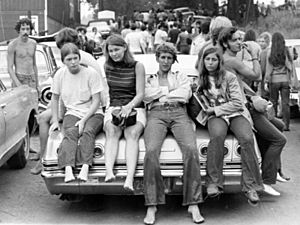Hippie facts for kids


A hippie (sometimes spelled hippy) was part of a counterculture movement. This movement started with young people in the United States in the mid-1960s. It then spread to many other countries around the world.
The word hippie comes from the slang word hip. Being "hip" meant you were "in the know" or "cool". It was the opposite of being "square", which meant being old-fashioned.
Contents
What Was the Hippie Movement?
The hippie movement was a youth movement that began in the 1960s. Hippies wanted to live differently from mainstream society. They often promoted peace, love, and freedom. They also cared about the environment.
Key Events and Gatherings
Many important events helped spread hippie culture.
The Summer of Love
In 1967, a big event called the Human Be-In happened in San Francisco. This event made hippie culture very popular. It led to the "Summer of Love" in San Francisco. Thousands of young people gathered there.
Woodstock Festival
In 1969, the famous Woodstock Festival took place on the East Coast of the United States. It was a huge music festival. Many hippies attended this event.
Hippies Around the World
The hippie movement was not just in the U.S.
- In Mexico, hippies were called jipitecas. They formed a group called La Onda. They gathered at the Avándaro festival.
- In New Zealand, some hippies lived in "housetruckers". They traveled and promoted sustainable energy. They gathered at Nambassa.
- In the United Kingdom, a huge Isle of Wight Festival happened in 1970. About 400,000 people attended.
- In Australia, hippies met at Nimbin for the 1973 Aquarius Festival.
- Chile had a major hippie event called "Piedra Roja Festival" in 1970.
- Even in Eastern Europe, behind the Iron Curtain, hippie ideas influenced young people.
Who Were the Hippies?
Most people who were part of the main hippie movement were born in the 1940s and early 1950s. These included the oldest of the Baby Boomers. Some younger members of the Silent Generation were also leaders. They helped start Rock music.
Hippie Influence on Culture
Hippie fashion and values had a big impact on culture. They influenced many areas, including:
- Popular music
- Television and film
- Literature and art
Many ideas from hippie culture became more common over time. For example, hippies believed in cultural diversity and different ways of thinking. They also explored Eastern philosophy and spiritual ideas. These concepts later became more accepted by many people.
Images for kids
-
A group of hippies in Tallinn, 1989
-
A 1967 VW Kombi bus decorated with hand-painting
-
Monument to the hippie era. Tamil Nadu, India
-
As a hippie, Ken Westerfield helped to popularize the alternative sport of Frisbee in the 1960s–70s, that has become today's disc sports
See also
 In Spanish: Hippie para niños
In Spanish: Hippie para niños
















